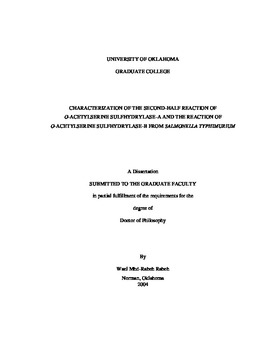| dc.contributor.advisor | Cook, Paul F., | en_US |
| dc.contributor.author | Rabeh, Wael Mhd-rabeh. | en_US |
| dc.date.accessioned | 2013-08-16T12:19:33Z | |
| dc.date.available | 2013-08-16T12:19:33Z | |
| dc.date.issued | 2004 | en_US |
| dc.identifier.uri | https://hdl.handle.net/11244/799 | |
| dc.description.abstract | The O-acetylserine sulfhydrylase-B (OASS-B) was recently overexpressed and purified to electrophoretic homogeneity (>98% pure). Both the quantity and purity of the enzyme permit more kinetic and structurally based studies to be conducted. Spectral studies were carried out to characterize the different enzyme forms of the B-isozyme and to compare it to those of the A-isozyme. UV-visible spectra of OASS-B were pH-dependent over the pH range (6--9) in the absence and presence of amino acid substrate, O-acetylserine (OAS). Titrating the free enzyme with the substrate analogs, L-serine, and the amino acid product, L-cysteine show behavior opposite to that observed with the A-isozyme. The pH-dependence of the pKESB for both amino acids yields one enzyme group on the acid side of the pH profile with a pKa value 6.9--7.7. (Abstract shortened by UMI.) | en_US |
| dc.description.abstract | O-acetylserine sulfhydrylase (OASS) catalyzes the last step in the cysteine biosynthetic pathway in enteric bacteria and plant, substitution of the beta-acetoxy group of O-acetyl-L-serine with inorganic bisulfide. The first half of the OASS-A reaction, formation of the alpha-aminoacrylate intermediate, limits the overall reaction rate, while the second half-reaction is thought to be diffusion-limited. The second half-reaction of OASS-A starts with bisulfide adding to Cbeta of the alpha-aminoacrylate intermediate to form the external Schiff base with cysteine, which is then released after transimination. The second half-reaction is very fast with a pseudo-first-order rate constant >1000 s-1; and as a result, limited information is available. Rapid-scanning-stopped-flow (RSSF) experiments were used in an attempt to detect intermediates along the reaction pathway. The pH(D) dependence of the second half-reaction has been determined using the natural substrate, bisulfide, and sulfide analogs. The pH-dependence of the first order rate constant for disappearance of the alpha-aminoacrylate intermediate was measured over the pH range (6.0--9.5) using the natural substrate bisulfide, and a number of nucleophile analogs. The rate is pH-dependent for substrates with a pKa > 7, while the rate constant is pH-independent for substrates with a pKa < 7 suggesting that the pKas of the substrate and enzyme group are important in this half of the reaction. In D2O, at low pD values, the amino acid external Schiff base is trapped, while in H2O the reaction proceeds through release of the amino acid product, which is rate-limiting. A number of new beta-substituted amino acids were produced and characterized by 1H NMR spectroscopy. Data are discussed in terms of the overall mechanism of OASS-A. | en_US |
| dc.format.extent | xv, 156 leaves : | en_US |
| dc.subject | Isoenzymes. | en_US |
| dc.subject | Sulfates | en_US |
| dc.subject | Enzymes Analysis. | en_US |
| dc.subject | Chemistry, Biochemistry. | en_US |
| dc.subject | Salmonella typhimurium. | en_US |
| dc.title | Characterization of the second-half reaction of O-acetylserine sulfhydrylase-A and the reaction of O-acetylserine sulfhydrylase-B from Salmonella typhimurium. | en_US |
| dc.type | Thesis | en_US |
| dc.thesis.degree | Ph.D. | en_US |
| dc.thesis.degreeDiscipline | Department of Chemistry and Biochemistry | en_US |
| dc.note | Source: Dissertation Abstracts International, Volume: 65-09, Section: B, page: 4559. | en_US |
| dc.note | Adviser: Paul F. Cook. | en_US |
| ou.identifier | (UMI)AAI3148885 | en_US |
| ou.group | College of Arts and Sciences::Department of Chemistry and Biochemistry | |
